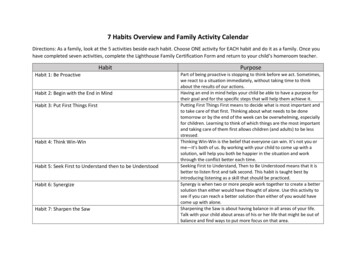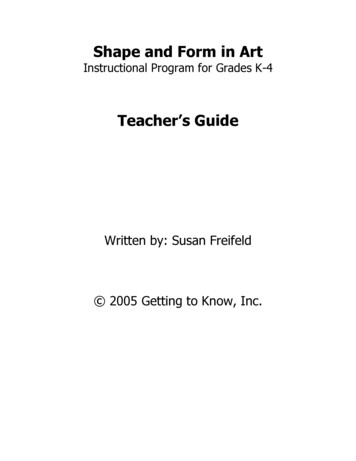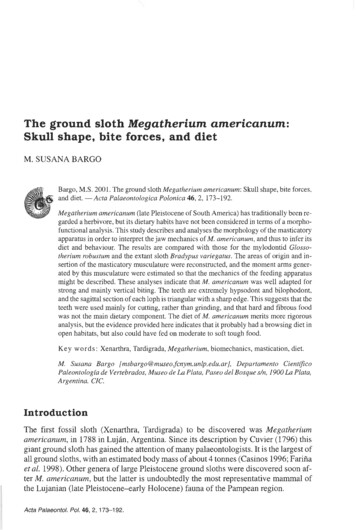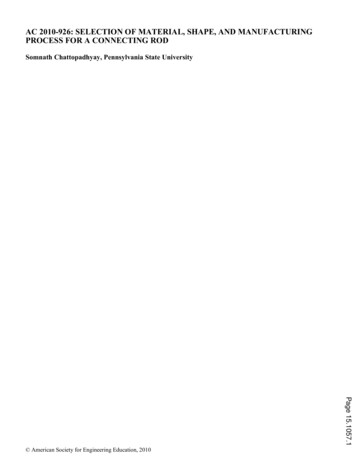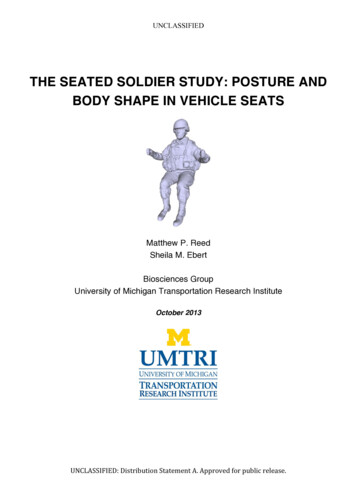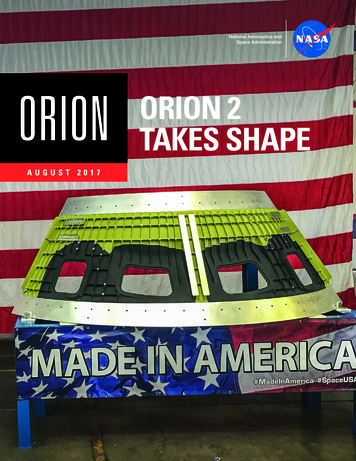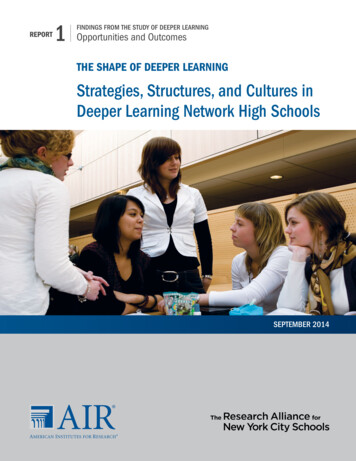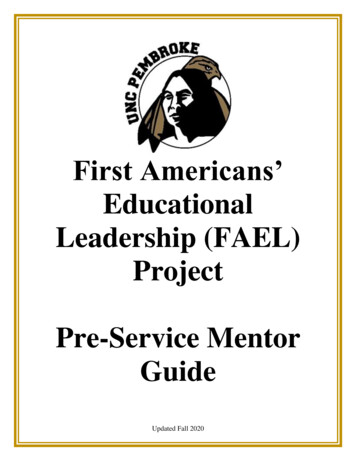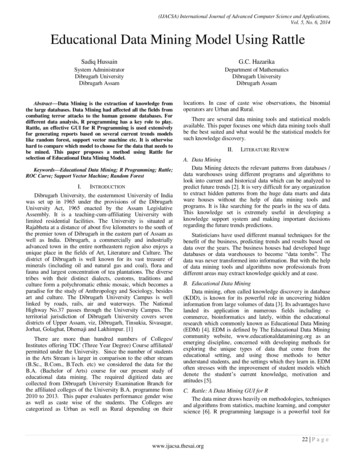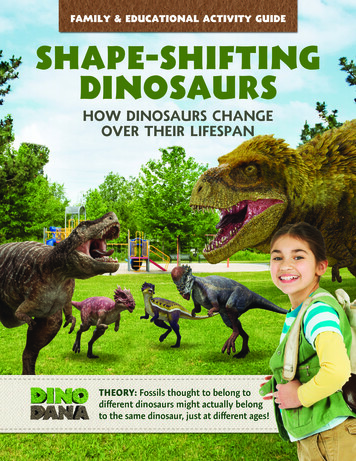
Transcription
Family & Educational Activity GuideShape-ShiftingDinosaursHOW DINOSAURS CHANGEOVER THEIR LIFESPANTHEORY: Fossils thought to belong todifferent dinosaurs might actually belongto the same dinosaur, just at different ages!
Information for parents & teachersABOUT THIS THEORYMuch of the information presented in this lesson camefrom research reported by Dr. Jack Horner and colleagues.The theory posits that certain dinosaurs changed shapeso dramatically over the course of their development thatpaleontologists mistakenly identified them as different dinosaursrather than the same dinosaur at different ages. This “shapeshifting dinosaur” theory is relatively new and not one that allpaleontologists agree with. Like all science, it is a process ofpresenting new ideas and theories and examining the evidence,which is what children will do here.Next GenerationScience StandardsNGSS 1-LS3-1: Make observations to constructan evidence-based account that young animalsare like, but not exactly like, their parents.NGSS 3-LS3-1: Analyze and interpret datato provide evidence that animals have traitsinherited from parents and that variation ofthese traits exist in a group of similar organisms.See movie website for additional NGSS fromthe Dino Dana seriesDINO DANA: THE MOVIEFrom multiple Emmy award-winning Sinking Ship Entertainment comesan action-packed dinosaur adventure aimed at kids and their families.Based on the popular TV series, Dino Dana: The Movie follows 10-year-oldpaleontologist-in-training Dana as she imagines dinosaurs into the real worldto solve her dinosaur experiments.DINO DANA created byJ.j. JohnsonMovIe Screenplay byJ.j. Johnson & Christin SImmsEducational Guide created byDr. Colleen Russo Johnsonpaleontologist consultantDr. David Evans2
TERMINOLOGYDinosaur (die-no-sore)A group of animals that became extinct around66 million years ago.Paleontologist (pay-lee-un-tol-uh-jist)Scientists who study dinosaurs.Science (si-uhns)A system of studying, testing, and experimentingto build knowledge.Theory (theer-ee)An explanation for why something happens.Hypothesis (high-poth-uh-sis)A prediction that can be tested.DINOSAURS FEATURED(And how to say them!)Tyrannosaurus RexNanotyrannus(TIE-RAN-OH-SORE-US K)(DRAY-CO-REX)3
AnimalsCOMPARE AND CONTRASTSome animals, like cats, look very similar as babies and adults. Can you compare and contrast thebaby kitten and adult cat? To start, answer “yes” or “no” to each of these questions:Are they the same size?Are they the same color?Are they the same shape?Do they both have a tail?Do they both have ears?Now put the similarities and differencesidentified above into this venn diagram.If you think of more, add them in!DIFFERENCESDIFFERENCESSIMILARITIESAre there more similarities or more differences between the kitten and cat?q More similarities q More differences4
There are other animals that change a lot as they grow.For example, flamingos change color as they get older!And baby frogs (called tadpoles) look VERY differentthan adult frogs!Can you compare and contrast the baby FROG and adult frog?Answer the questions, then decide whether there are more things the same or more things different.Are they the same size?Are they the same color?Are they the same shape?Do they both have a tail?Do they both have legs?Are there more similarities or more differences between the baby frog (tadpole) and adult frog?q More similarities q More differencesACassowary SkullsABCRESTBBEAKABABADULTKIDCrestBABYNo crestCassowary birds (and otherbirds with crests on theirheads) don’t actually growtheir crest until they’re nearlyadults. So if you found both ababy and an adult Cassowary,you would think they weretwo different bird species!If we only looked at the way that the Cassowary birdswere different as they grew, we might not realize theywere the same bird. We have to also look at the waysthey are the same.Can you think of one way they are similar?SIMILARITY:ADULTKID5
WHERE ARE ALL THEBaby DINOSAURS?Did some dinosaurs alsochange how they lookedas they grew older?I’m testing a theory to see if somedinosaurs are actually just younger versionsof other dinosaurs! Can you help me?If this theory is true, then it meansdozens of different dinosaur names mayno longer exist if they are actually justthe same dinosaur at different ages!“The crested duck-billed dinosaurs from Alberta, Canada provide the best example of howpaleontologists can be confused by changes as a dinosaur grows up. All of these growthstages of the Corythosaurus (see below) found in Dinosaur Provincial Park were nameddifferent species by early paleontologists. It wasn’t until the work of Dr. Peter Dodsonthat we realized the smaller skulls with smaller crests were just younger examples of thebigger species. The crest gets proportionally bigger as the animal grew up!”DR. DAVID C. EVANSPaleontologist— Dr. David EvansCorythosaurus CRESTNo crestBABYCrest formingFull crestKIDADULTKID6
Tyrannosaurus RexTime to start exploring and testing this theory!Let’s start with the KING OF THE DINOSAURS:The mighty T. rex. Is the Nanotyrannus actuallya baby version of the Tyrannosaurus rex?Tyrannosaurus RexNanotyrannusThe Nanotyrannus is smaller than the T. rex, which makessense if it was a younger T. rex. But let’s take a closer look atthe skulls of each dinosaur to compare them more!Count the number of teeth on each jaw! Which has more?NanotyrannusTEETHT. rexTEETH7
What did you discover? I counted that theNanotyrannus has 17 teeth and the T. rex has12 teeth. But if our hypothesis is that theNanotyrannus is a baby version of the T. rex,that means T. rexes LOST teeth as they got older.Let’s test this new hypothesis by counting howmany teeth T. rexes of different ages had!You already counted the number of teethon the Nanotyrannus and the full grownT. rex. This time, count the number ofteeth on the younger T. rexes.Count the number of teeth on each skull! Which has more?1 7 TEETHTEETHTEETHBased on my counts, as T. rexes gotolder, they DID lose teeth! This evidencesupports our hypothesis that theNanotyrannus is a baby T. rex!12TEETHModern Platypusesalso lose theirteeth as theyget older!8
What can we learn from acloser look at the bones?Another way that we can test whether theNanotyrannus is a baby is by looking at thebones! Paleontologists sometimes cut intodinosaur bones, or use x-ray machines to lookat the inside of the bone.LET’S PEEK INSIDE!Bone Histology means examining theinside of bones. We can do this todetermine the dinosaur’s age! Bones havegrowth rings, just like trees. The moregrowth marks, the older the dinosaur is.Count the growth rings on each dinosaur boneand circle which one has more!NANOTYRANNUST. REXThat’s right! The T. rex has more growth rings, which means it’solder than the Nanotyrannus. This is even MORE evidence tosupport our hypothesis that the Nanotyrannus is a baby T. rex!9
PACHYCEPHALOSAURUS,STYGIMOLOCH andDRACOREXLet’s continue our experiment We know thatthe dome-headed Pachycephalosaurus is anadult dinosaur, but where are all the youngerPachycephalosaurus URUSADULTSome paleontologists believe thatthe Dracorex and Stygimoloch areactually the Pachycephalosaurus atdifferent developmental stages.What do you think? Could the Dracorex be a babyPachycephalosaurus, and the Stygimoloch be a kidPachycephalosaurus?Let’s look at some of the facts All 3 are herbivores(which means they ateplants, not meat!)All 3 lived during theCretaceous Period(68 to 66 million years ago!)All three lived in the same place(what is now westernNorth America)All these similarities mean that they COULD be from thesame family! Let’s test this hypothesis by comparing moreof their features.10
Let’s take a closer look at eachof their heads to see what’s the sameand what’s different!Circle the description that best fits the dinosaur!The Dracorex has been done as an example!Medium spikesNo domeHas bumpsDRACOREXSTYGIMOLOCHPACHYCEPHALOSAURUSDome on HeadNo DomeNo DomeNo DomeTiny DomeTiny DomeTiny DomeLarge DomeLarge DomeLarge DomeSPIKES ON BACK OF HEADSmall SpikesSmall SpikesSmall SpikesMedium SpikesMedium SpikesMedium SpikesLarge SpikesLarge SpikesLarge SpikesBumps on NoseHas bumpsHas bumpsHas bumpsNo bumpsNo bumpsNo bumps11
Here are THE results!DRACOREXSTYGIMOLOCHPACHYCEPHALOSAURUSDome on HeadNo DomeNo DomeNo DomeTiny DomeTiny DomeTiny DomeLarge DomeLarge DomeLarge DomeAre they all the same or different?Back of HeadSmall SpikesSmall SpikesSmall SpikesMedium SpikesMedium SpikesMedium SpikesLarge SpikesLarge SpikesLarge SpikesAre they all the same or different?Bumps on NoseHas bumpsHas bumpsHas bumpsNo bumpsNo bumpsNo bumpsAre they all the same or different?So they have features that areboth similar and different.Why might they grow long spikes and havethem get short again?One theory is that they had different predators at different sizes and the spikeshelped at the kid Stygimoloch size but not the adult Pachycephalosaurus size.Another idea is that the size of the horns signalled their age and social status toother members of their own kind.12
LET’S COMPARE THEIR SIZES!It’s clear that they are all different sizeswhich makes them different, BUT it couldalso explain the Dracorex being a baby,the Stygimoloch being a kid, and thePachycephalosaurus being the adult.DINO LINE abyKidADULT13
WHAT CAN WE LEARN FROM A CLOSERLOOK AT THE SKULL BONE?When a bone texture is ‘spongy’ (with more space for bloodvessels), it means the dinosaur’s bones were still growing when itdied, which tells us it was a younger dinosaur! The more compactthe texture, the older the bone was when the dinosaur t boneSpongy boneSolid boneThis means the Dracorex bone is stillgrowing really fast, which means it’sstill a baby and will get bigger.This means the Stygimoloch bone isalso still growing so it’s likely a youngdinosaur! The dome is very spongyshowing that it’s growing quickly.This means the Pachycephalosaurusbone is no longer growing. Thisconfirms that the Pachycephalosaurusis an adult!Even though these are all differences,it is more evidence to support ourhypothesis that these are the samedinosaur at different ages!14
LET’S COMPARE MORE FEATURES!We have found a lot of things that areDIFFERENT about these three dinosaurs.But maybe we need to stop looking at whatmakes things different, and start looking atwhat makes things the same!If you are going to determine if you’rerelated to a sibling, you can’t do it bylooking at differences. You need tolook at similarities.– Dr. Jack HornerFill in the blanks below to keep comparing these dinosaurs’features! Can you find some similarities?IN WHAT PERIOD DID THE DINOSAUR LIVE?CRETACEOUS PERIOD(68 to 66 million years ago)CRETACEOUS PERIOD(68 to 66 million years ago)CRETACEOUS PERIOD(68 to 66 million years ago)DIET CLASSIFICATIONHERBIVORE (plant eater)HERBIVORE (plant eater)HERBIVORE (plant eater)locationWESTERN NORTH AMERICAWESTERN NORTH AMERICAWESTERN NORTH AMERICANUMBER OF LEGS?Short or long arms?15
FINDINGSLet’s summarize our KIDADULTWhat is different?No dome on headTiny dome on headLarge dome on headMedium spikes on back of its headLarge spikes on back of its headSmall spikes on back of its headWhat is the same?Has bumps on noseHas bumps on noseHas bumps on noseFrom the Cretaceous PeriodFrom the Cretaceous PeriodFrom the Cretaceous PeriodHerbivoreHerbivoreHerbivoreTwo legsTwo legsTwo legsShort armsShort armsShort armsLived in North AmericaLived in North AmericaLived in North AmericaEvidence it is still growingSmallest sizeMedium sizeLargest sizeSkull bone is the spongiesttexture, so still growingSkull bone is a spongytexture, so still growingSkull bone is a solid/maturetexture, no longer growing16
CONCLUSIONThe data supports our hypothesis!Even though there are some differencesbetween the three dinosaurs, there are morethings that are the same than different! If wehad just focused on the differences, we wouldhave never noticed their similarities.In the movie, Dana uses her imagination and field guide to get the Dracorex,Stygimoloch, and Pachycephalosaurus together to see how they behaved.Her hypothesis was if they tried to fight each other, they were probably notrelated. What she observed supports the theory of them being in the samefamily, because the three dinosaurs were getting along and protectingeach other! This means they were likely all Pachycephalosaurusdinosaurs but at different ages: Baby, Kid, and Adult!Every time they found something that looked a little bit different,they named it something different. And what happened is we ended upwith a whole bunch of different dinosaurs.– Dr. Jack HornerTHERE’S MORE!Some paleontologists also believe that the Anatotitan is actually an adultversion of the Edmontosaurus, and the Torosaurus is an adult version ofthe Triceratops! Because the Edmontosaurus and Triceratops were namedfirst, those names remain!17
an action-packed dinosaur adventure aimed at kids and their families. Based on the popular TV series, Dino Dana: The Movie follows 10-year-old paleontologist-in-training Dana as she imagines dinosaurs into the real world to solve her dinosaur experiments. Educational Guide created by Dr. Colleen Russo Johnson paleontologist consultant Dr. David Evans DINO DANA created by J.j. Johnson MovIe .

